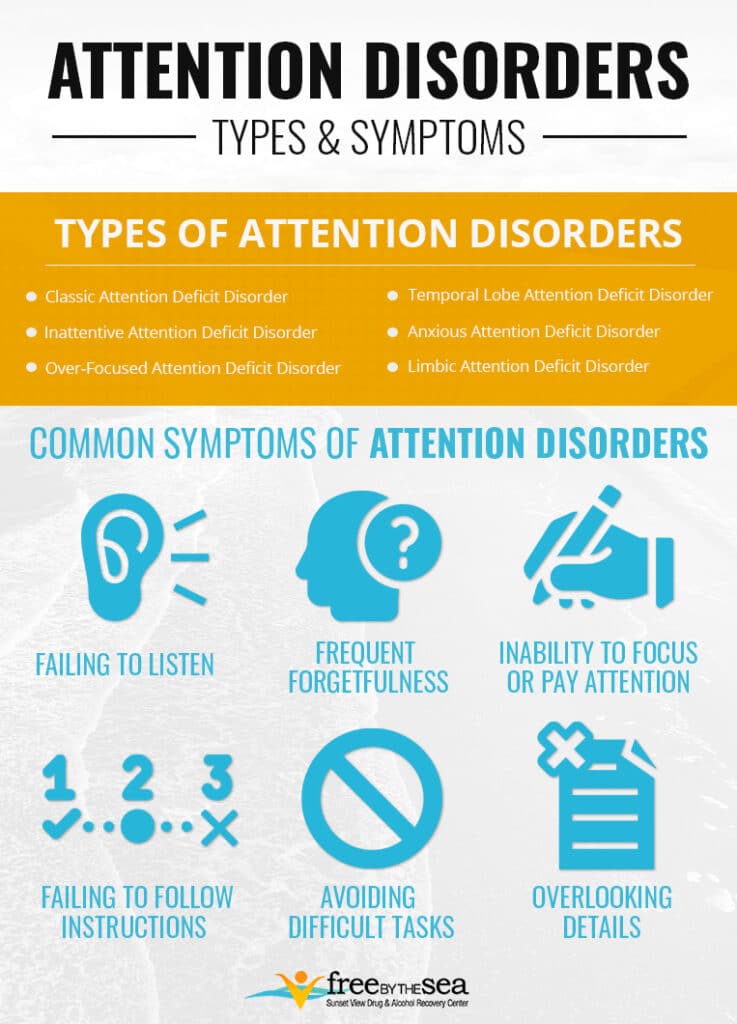 When an individual has trouble paying attention or controlling impulses, a healthcare professional will usually diagnose an attention disorder. One of the most common attention disorders recognized by healthcare professionals today is attention deficit disorder (ADD).
When an individual has trouble paying attention or controlling impulses, a healthcare professional will usually diagnose an attention disorder. One of the most common attention disorders recognized by healthcare professionals today is attention deficit disorder (ADD).
ADD shares symptoms with several other conditions, however, so it is critical that the disorder receive a proper diagnosis. Located in the State of Washington, Free by the Sea has a well-trained staff uniquely qualified to help diagnose and provide treatment for a wide variety of attention disorders.
Classic Attention Deficit Disorder
Classic attention deficit disorder is more commonly known as ADD. Because the condition is common and well-researched, ADD is easy to diagnose. Common symptoms of attention deficit disorder are as follows:
- Hyperactivity
- Disorganization
- Failing to pay attention
- Becoming easily distracted
- Inability to control impulses
Attention deficit disorder symptoms are not limited to the ones listed above. Brain scans taken from people who have been diagnosed with ADD often show regular brain activity during restful periods. However, when a person who has attention deficit disorder takes part in a focus-intensive task, scans of their brains reveal a low amount of activity.
To treat this mental health disorder, a healthcare professional will prescribe Ritalin or recommend other natural remedies that will help increase dopamine levels. Regular exercise is also recommended to manage ADD.
Inattentive Attention Deficit Disorder
Healthcare professionals will give a diagnosis of inattentive ADD when they observe extremely low dopamine levels and a decrease in the activity of the prefrontal cortex. Individuals with inattentive ADD don’t demonstrate hyperactive or impulsive symptoms. Females are also more commonly diagnosed with inattentive ADD than males. Some symptoms of inattentive ADD are the following:
- Procrastination
- Disorganization
- Becoming easily distracted
- Inability to pay attention for extended periods of time
People with inattentive ADD do not display the same hyperactive or impulsive symptoms as those with ADD. However, they do tend to withdraw from others and engage in daydreaming often. This attention disorder is typically treated by increasing the patient’s dopamine levels.
Over-Focused Attention Deficit Disorder
Individuals with over-focused ADD generally exhibit all of the basic ADD symptoms. The difference between the two attention disorders is that people with over-focused ADD present the additional symptom of having trouble with shifting attention. People with over-focused ADD tend to focus on negative thoughts or exhibit negative behavior.
Over-focused ADD is characterized by a decrease in both dopamine and serotonin levels and an overactive anterior cingulate gyrus (which is commonly called the brain’s “gear shift”). Healthcare professionals treat over-focused attention deficit disorder by increasing the patient’s dopamine and serotonin levels.
Temporal Lobe Attention Deficit Disorder
The brain’s temporal lobe is responsible for regulating memory, learning, and mood. When an individual is coping with temporal lobe ADD, they struggle with learning, memory, and severe anger or aggression. At times, they exhibit symptoms of extreme paranoia. Temporal lobe ADD is generally treated with magnesium supplements, which specifically treats their symptoms of anxiety and irritability.
Limbic Attention Deficit Disorder
A person diagnosed with limbic ADD will show all of the basic ADD symptoms but will also frequently feel an underlying sense of sadness. Other symptoms observed in an individual with limbic ADD include the following:
- Moodiness
- Fatigue
- Feelings of guilt and helplessness
- Feelings of low self-esteem
Despite what they may imply, the symptoms of limbic ADD do not indicate depression. A patient with limbic ADD actually has an overactive limbic area in their brain. The limbic area is responsible for regulating mood. Limbic ADD is treated by increasing a patient’s dopamine levels.
Ring of Fire Attention Deficit Disorder
Ring of Fire ADD gets its name from the familiar “red ring” that shows up in brain scans of individuals with this attention disorder. Essentially, a person who has this kind of attention deficit disorder has several overactive areas throughout their brain. Symptoms of this type of ADD tend to be sporadic. Some examples include, but are not limited to, the following:
- A display of unpredictable behavior
- Sensitivity to light and noise
- Periodic bursts of mean or nasty behavior
- Periodic bursts of anxiety
- Periodic bursts of paranoia
Treatment for ring of fire ADD includes diet changes and blood pressure medication. Stimulants, however, may be harmful when prescribed to people with this attention disorder.
Anxious Attention Deficit Disorder
Anxious ADD is characterized by the basic symptoms of attention deficit disorder accompanied by tension, anxiety, stomachaches, and headaches. Typically, physical aches and pains manifest due to stress. Brain scans of individuals suffering from anxious ADD show very high basal ganglia. Anxious attention deficit disorder is treated through the use of antidepressants, calming supplements, and relaxation.
How Are Attention Disorders Diagnosed?
A patient must present symptoms of an attention disorder for at least six months before a healthcare professional can make a diagnosis. Symptoms usually interfere with a person’s work or school life. The most common attention disorders symptoms are as follows:
- Inability to focus or pay attention
- Failing to listen
- Frequent forgetfulness
- Overlooking detail
- Failing to follow instructions
- Avoidance of difficult tasks
Common symptoms of hyperactivity are as follows:
- Interrupting others
- Fidgeting or squirming
- Talking excessively
- Being active in unsuitable situations
Dual Diagnosis and Attention Disorders
When someone is struggling with addiction and an attention disorder at the same time, it is referred to as a dual diagnosis. Regardless of which illness came first, it is imperative to recognize the destructive nature of two diseases occurring at the same time. For example, co-occurring disorders can worsen both illnesses, as if they weren’t difficult enough to deal with on their own. If others are to properly combat a dual diagnosis, it is important that they understand every aspect of it.
In contrast to understanding dual diagnoses, there are misconceptions as it relates to the nature of co-occurring disorders. One of the most common misconceptions is that one disease influenced the other. This couldn’t be farther from the truth. Suffering from substance use disorder does not guarantee someone will suffer from an attention disorder; they can be completely independent of one another and exist simultaneously, though it can be difficult to understand which one comes first.
Nearly a quarter of all males who suffer from an attention disorder like ADHD also suffer from substance abuse. This number is lower in females at 13%. There are many reasons that someone who suffers from ADHD or any other attention disorder may turn to substance abuse. This has to do largely with the impact that an attention disorder has socially, professionally, or educationally. Because of these roadblocks that those with an attention disorder experience, these individuals cope with abusing substances.
Someone could have been suffering from an attention disorder their whole lives before they developed a substance abuse problem. Not only that but attention disorders, depending on the case, could have very little effect on someone’s substance abuse issues. What’s most important to remember is that both of these are occurring at the same time.
For those who suffer from an attention disorder and substance use disorder at the same time, there are plenty of options available to heal. Co-occurring disorders are scary, and sitting in the middle of it is worse than being caught in the middle of the perfect storm. There are many individuals at Free By The Sea who are ready to meet patients where they are in their substance abuse journey.
Why Choose Free by the Sea?
A beautiful campus in Ocean Park, Washington, Free by the Sea works to help individuals who suffer from substance use disorder and attention disorders. Treating others with respect and helping them become their best selves is our mission here. There is no one-size-fits-all solution to substance use disorder or attention disorders. This is why individualized treatment is at the center of our practices. Some of these practices include the following:
- Relapse prevention plans
- Life-skills development
- Addiction education
- Individual therapy
- Group therapy
- Nutritional meals
- Residential treatment
- Outpatient treatment
- Peaceful atmosphere
- Close proximity to the ocean
- Partial hospitalization programs
- Twelve-step meetings like AA/NA/GA
- Professional therapists and psychiatrists
- Treatment beds for the comfort of our patients
- Volleyball/basketball courts and an exercise room
- Treatment perfected through evaluated experience
- Treatment that addresses other disorders such as depression and anxiety
Get the Help You Need Today for Attention Disorders and Addiction
Substance use disorders and attention disorders can dampen the quality of one’s life. In order to pursue a healthy, fulfilling, and purposeful life, treatment may be necessary; just because it is necessary does not make anyone any less of a human being. Doing so just means someone is being proactive in taking the right steps to be healed. There are many who may suffer worse than ever because they neglect to acknowledge their attention disorder or addiction.
If you or a loved one suffer from an addiction or an attention disorder, you can contact us here. Free by the Sea is a leading and trusted resource for treatment of all kinds of attention disorders in men and women. Many therapy options are available to help in a variety of situations. Contact us now for more information about treatment for you or your loved one’s attention disorder.

Dr. Richard Crabbe joined our team in 2019 as our psychiatrist and medical director. He attended the University of Ghana Medical School where he became a Medical Doctor in 1977. From 1978 through 1984, he was a medical officer in the Ghana Navy and provided a variety of services from general medicine to surgeries. He received his Certificate in General Psychology from the American Board of Psychology and Neurology in 2002.


